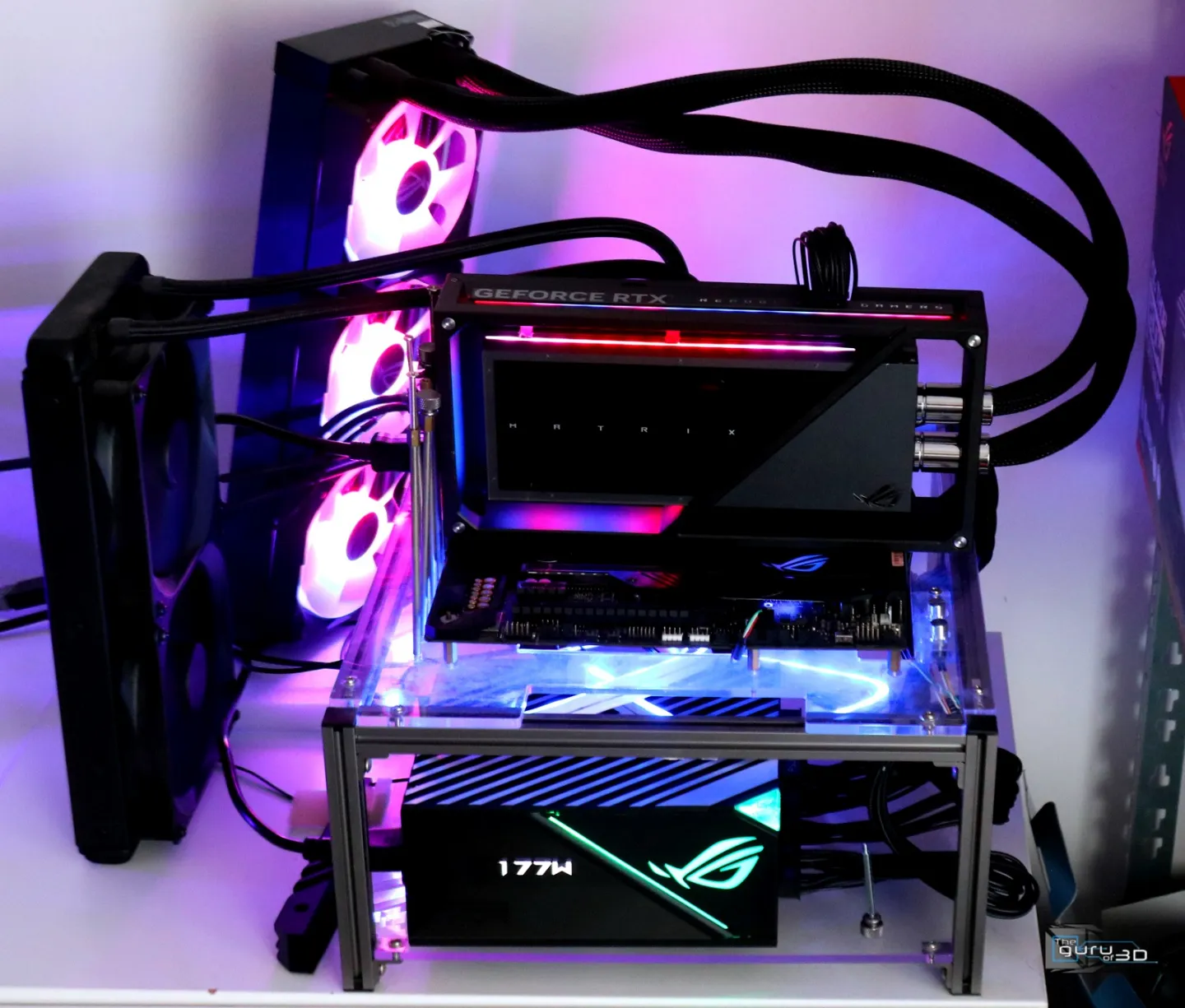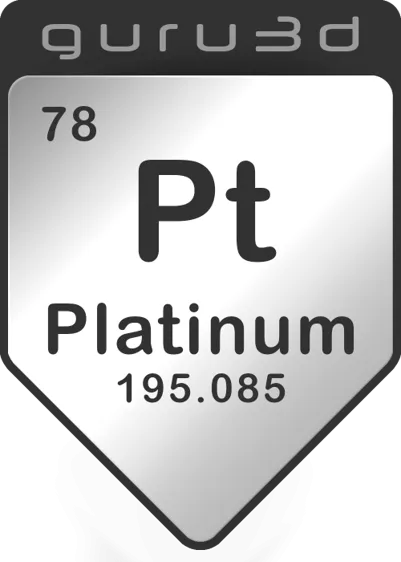Final words and conclusion
Final words
The ASUS ROG Matrix Platinum edition of the GeForce RTX 4090 offers notable performance enhancements. Not only does it provide an approximate 6-8% performance improvement over the reference model, it also offers a silent operation while maintaining effective cooling. When considering the price point, which is expected to be around 2000 USD, the cooling efficiency of this GPU stands out, with ASUS configuring the product to operate at a temperature of 60~65°C in silent BIOS mode. This results in an acoustic level of about 33 dBA. In terms of performance, that 6-8% increase compared to the reference model, varying with workload and resolution. Analyzing its shader capabilities, the product demonstrates a significant performance improvement over previous generation models. Additionally, there's a marked enhancement in raytracing performance and added raytracing features. NVIDIA has integrated improved Tensor cores to support the new DLSS 3.5, potentially delivering up to a 2x performance boost with future raytraced deep learning capabilities. However, with a TBP of 450 Watts, especially in the current era of rising energy prices, it raises concerns about energy consumption and its environmental impact. Overall, while the performance is impressive, these considerations might influence its overall appeal.
Performance
In the preceding paragraph, I highlighted the importance of game performance and rendering quality. The GeForce RTX 4090 excels in these areas, though a MATRIX RTX 4080 would have offered a better cost-to-performance ratio. The RTX 4090 approaches performance levels suitable for 8K resolution gaming. However, it's essential to note that many avid gamers typically use monitor resolutions such as UWHD, QHD, or UHD. Using the RTX 4090 for Full HD gaming could lead to bottlenecks and CPU limitations. Nevertheless, certain well-optimized games, especially those utilizing DX12/ASYNC computation, can experience significant performance improvements with this card. The RTX 40 series introduces an advanced generation of Ray tracing and Tensor cores, providing more power. While the specific counts of RT and Tensor cores are important, the primary focus should be on the performance each unit delivers. These cores' proximity to the rendering engine has led to increased efficiency. Although Tensor cores' performance is challenging to quantify, preliminary observations, such as those from DLSS3, indicate positive results. The GeForce RTX 4090 is optimized for resolutions ranging from 2K 2560x1440 to 4K (3840x2160). Different architectures will inevitably present varying performance metrics due to their respective strengths and weaknesses in specific game render tasks. When assessing performance on a per-card basis, ASUS's product outperforms anything, attributed to a higher TGP, increased clock frequencies, and optimal temperatures.
Cooling & noise levels
Liquid cooling presents itself as a notable GPU solution. ASUS's MATRIX utilizes this full-on. Under high-stress conditions with silent BIOS mode (not the default setting), the card records around ~33 dBA. When subjected to substantial loads, the card's temperature may approach 60-65°C. For the performance mode, you'll sit between 55-60 Degrees C yet breach 38-39 DBa on acoustics. Personally, for the small temperature differential, the Silent BIOS mode would be an easy-to-make choice. FLIR imaging hasn't shown any concerning readings.
Energy
The GeForce RTX 4090 has a serious power consumption, particularly during intensive gaming sessions. With current rising energy prices, this card draws around 425 Watts on average, a factor to consider when evaluating its performance benefits.
Coil Whine
The ASUS GeForce RTX 4090 exhibits coil whine, similar to its predecessor, the 3090. This noise is noticeable, especially in an open chassis. While most graphics cards produce coil whine to some extent, particularly at high framerates, it is discernible in the RTX 4090. In a closed chassis, the noise is less prominent.
Pricing
The founder edition GeForce RTX 4090 from NVIDIA is priced at USD 1599. The ASUS MATRIX 4090 is available at USD 3200. Both are significant investments primarily used for PC gaming.
Above results show respective default clocked results plotted in percentages. To the far right where you can see "Aver Difference %", this is the result of the four games tested and averaged out.
Tweaking
The ADA card is capable of tweaking, with the GPU potentially reaching up to ~3.1 GHz (dynamic boost frequency). The clock frequency can accommodate an additional +200 MHz, resulting in a GPU boost clock ranging between 3000-3100 MHz, though this varies with different game titles or resolutions due to dynamic frequencies. The power limiter can be increased by 20%, and the memory can be adjusted to a massive 24 Gbps. These changes yield a 9% performance improvement in demanding GPU scenarios when compared to the founder edition's baseline performance and a 3% improvement from this card's original performance. This will not justify the effort, potential risk, and energy additional power consumption which rises close to 500 Watts.
Conclusion
In the realm of high-performance GPUs, the ASUS ROG Matrix Platinum GeForce RTX 4090 is a notable contender in the 4090 series, especially for those who appreciate quiet operation. The design decisions made by ASUS in this product are commendable, reflecting a keen attention to detail. For enthusiasts eagerly anticipating the next big thing in GPU tech, the ASUS ROG Matrix Platinum GeForce RTX 4090 is an impressive revelation. Featuring board partner cards that are customized, finely tuned, and effectively cooled, this unit stands out. The liquid cooler atop the ADA GPU underscores its advanced engineering. Aesthetically, it's a visual treat. The two-tone square aluminium design on the cooler shroud and backplate grants it a unique, futuristic appearance. It's equipped with three DisplayPorts and two HDMI video outputs. The backplate boasts a contemporary, almost cubist design, enhanced by RGB finishing touches. The conveniently positioned dual-BIOS switch offers a silent mode that maintains performance while ensuring the GPU operates at a cool 60-65°C under intensive loads. But it's not just about aesthetics and cooling; the technical upgrades are noteworthy too. With a significant increase in shader cores, nearly double the ray tracing and tensor cores, and innovative technologies like Shader Execution Reordering (SER) and DLSS 3.5, the RTX 4090 truly sets a new benchmark for the Series 4000 GPUs. The GeForce RTX 4090 AD102 GPU boasts an impressive 76.3B transistors, showcasing the potential of this advanced technology. The graphics card truly excels for those aiming for Ultra HD gameplay or at a starting monitor resolution of 2560x1440. Given its specialized nature, the aforementioned cons might not be deterrents for enthusiasts as such components are truly in a league of their own. Its design and capabilities make it a standout product in the tech landscape. However, potential users should be aware that the RTX 4090 emits a significant amount of heat, so adequate ventilation is essential. Weighing in at 2kg, its extended size due to tubing and weight demands a spacious PC build.
When it comes to performance, the results speak for themselves. Games like Flight Simulator 2020, combined with DLSS 3.0, allow for gameplay at 100+ FPS in superior resolutions. Meanwhile, titles like Cyberpunk in UHD with raytracing and DLSS exceed 100 FPS with ease. This card truly excels in Ultra HD, demonstrating its prowess in both standard rendering and hybrid ray-tracing + DLSS. Priced at 3200 USD, its value is smashed though when compared to other cards in its range. Its cooling system is top-tier, maintaining a serene operation. The reduced GPU temperatures also translate to a slight boost in overall frequency performance. If you're financially equipped and considering something extremely cool, the ASUS ROG Matrix Platinum GeForce RTX 4090 is a stellar choice — a commendable piece of hardware indeed. You'll just have to sell a kidney in order to be able to afford it.
Note: we initially expected a $1999 pricetag, however, that seems to be $3200. We're still waiting for a final conformation from ASUS and will tweak this conclusion a notch once we have that final number 100% verified.
Download NVIDIA GeForce drivers
Sign up to receive a notification when we publish a new article.
Or go back to Guru3D's front page
- Hilbert, LOAD"*",8,1.




